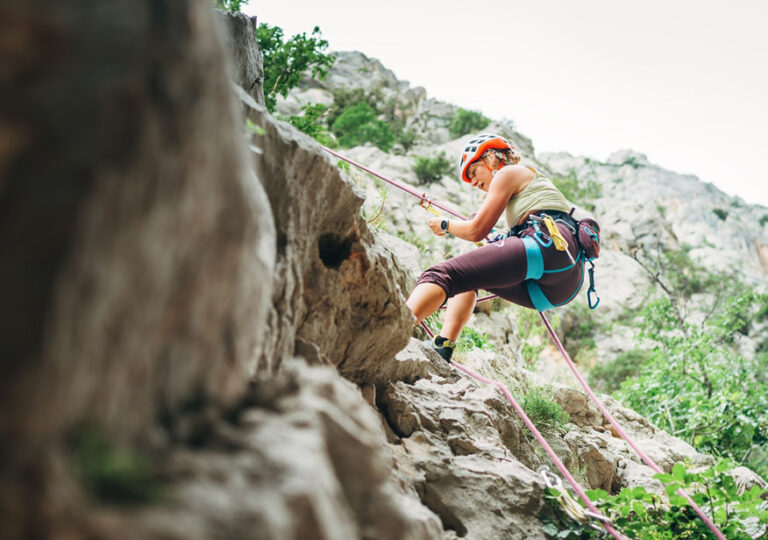If you want to explore cliffs you can’t reach on foot and push your climbing skills to the max, try your hand at lead climbing. It requires more coordination, planning and endurance to get to the top of the mountain compared to top roping. There’s a bit of a learning curve to this type of climbing, considering you will have to forge your own way and clip the rope to the rockface instead of relying on a preplaced anchor.
The good news is that you can expect to get one epic workout. Climbers typically burn anywhere from 400 to 600 calories an hour. Use this guide to learn how to lead climb like the pros, so you can start taking your expeditions to the next level.
Learn the Basics
Let’s start with understanding the basics of lead climbing. Unlike top roping where you are supported by a rope that’s been placed at the top of the cliff, you are responsible for bolting the rope to the rockface using removable pieces of quad gear. That means slowly inching your way up the mountain and reinstalling another quad every few feet.
When you want to advance the route, you venture beyond the quad or the “sharp end of the rope” and then reattach the clip to a higher spot on the cliff. If you fail to mount the next quad and lose your footing, the fall will be twice the distance between you and the next closest quad. If you climb five feet above the last anchor, expect to fall 10 feet before it catches you — plus any slack coming from the rope.
Use the Packtalk Outdoor to Talk Hands-Free While Climbing
Practice Clipping and Unclipping
There won’t be a rope to catch you unless you install one. You’ll need to get comfortable inserting the removable quads into the rocks. Spend time going over the different types of quads and how they attach. The crack needs to be large and stable enough to support the quad. It should be secure enough to support your weight but not too deep or it may be difficult for other climbers to remove.
You should also be quick with a carabiner, so you can clip yourself to a bolt or quick release. One hand needs to stay on the cliff while the other hand clips to the anchor. It should be below your head and above your waist to keep it within reach.
The faster you can move through these steps, the more energy you will conserve.

Source: wavebreakmedia/Shutterstock.com
Take a Lead Climbing Course
The best way to start lead climbing is to learn from someone who has done it before, either a buddy or a professional climbing instructor. They will be there to answer your questions and help you avoid common mistakes that can ruin your ascent.
Prepare Your Equipment
You will need to rent or buy all the essential rock climbing equipment, including ropes, carabiners, quads and clips that can support your weight. These items should be in good condition. Watch out for fraying ropes, bent clips and rusted pieces of metal that might start to lose their grip.
The Ultimate Rock Climbing Equipment List
Stay Calm
Lead climbing isn’t for the faint of heart. You will need to master your fear of heights and learn how to stay calm when you aren’t sure where to go next. Fear can easily get the better of you if you start to imagine the worst-case scenario. It always helps to surround yourself with more experienced climbers who can talk you off a ledge in an emergency.
Use the Packtalk Outdoor to communicate wirelessly with your fellow climbers. It connects automatically when in range and won’t interfere with your ability to scale the rocks. Just speak into the headset to talk to the next closest climber if you run into any trouble along the way.
Start small and slowly work your way up to steeper and taller cliff faces until the fear subsides.
Do a Practice Run
Repeating the same steps over and over will help you build confidence on the mountain. You can give yourself more room for error by using a top rope while lead climbing, so you don’t have to worry about falling as far. This is often referred to as a mock lead. Once you get the hang of it, you can leave the top rope behind and start exploring routes that don’t come with built-in quads and anchors.

Source: Soloviova Liudmyla/Shutterstock.com
With a little bit of planning and practice, you will be on your way to becoming an experienced lead climber. Go slow and take your time securing yourself to the mountain so you can get back up and go for another climb if you fall.





